
Introduction: The Challenge of Hidden Knowledge
In today's knowledge economy, what an organization knows has become its most critical strategic asset. Yet paradoxically, many companies struggle to answer a fundamental question: What knowledge resides within our organization, and where exactly is it located?
This challenge is particularly acute in small and medium-sized enterprises (SMEs), where crucial expertise often exists only in the minds of experienced employees. As Peter Drucker famously noted, "Knowledge has become the key economic resource and the dominant source of competitive advantage" — but this advantage is only realized when knowledge is accessible and transferable, not locked away in organizational silos or individual minds.
Traditional knowledge management initiatives often focus on implementing technological solutions or documentation systems. While these approaches have their place, they frequently fail to uncover the rich tacit knowledge — the know-how, experience, and insights that employees possess but rarely document. This tacit knowledge represents up to 80% of an organization's intellectual capital, according to research by Dalkir (2017), yet remains largely invisible to management.
This article introduces a powerful but underutilized approach to knowledge discovery: the "Knowledge Gemba Walk." Adapted from lean manufacturing principles, this methodology offers leaders a structured way to observe knowledge flows, identify critical expertise, and break down knowledge silos through direct observation and engagement with employees.
By exploring where knowledge resides, how it flows, and where it gets stuck, organizations can transform their abstract "knowledge assets" into tangible resources that drive innovation, efficiency, and competitive advantage. This article will provide a comprehensive framework for implementing Knowledge Gemba Walks, complete with preparation guidelines, execution strategies, and methods for translating observations into actionable knowledge management initiatives.
1. Understanding the Gemba Walk Concept
1.1 Origins in Lean Manufacturing
The concept of "Gemba" originates from Japanese manufacturing philosophy, particularly within the Toyota Production System (TPS). In Japanese, "Gemba" (現場) literally means "the actual place" — the location where value is created. In manufacturing, this refers to the factory floor; in service industries, it might be wherever customer interactions occur.
The Gemba Walk was developed as a management practice where leaders regularly visit the actual workplace to observe processes, engage with employees, and identify improvement opportunities firsthand. This practice embodies the principle of "Genchi Genbutsu" (現地現物), which translates as "go and see for yourself" — a cornerstone of Toyota's approach to problem-solving and continuous improvement.
Taiichi Ohno, one of the architects of the Toyota Production System, was famous for his "Ohno Circle" exercise, where he would draw a circle on the factory floor and have managers stand in it for hours, observing operations to identify waste and improvement opportunities. This direct observation approach countered the tendency of management to rely solely on reports and meetings, disconnected from the realities of daily operations.
As Fujio Cho, former Chairman of Toyota Motor Corporation, simply put it: "Go see, ask why, show respect" — encapsulating the essence of effective Gemba Walks. The practice emphasizes leadership through direct observation, questioning, and collaborating with those who do the actual work.
1.2 Adapting Gemba to Knowledge Work
While traditional Gemba Walks focus on physical processes and visible workflows, the Knowledge Gemba Walk adapts this concept to the less tangible realm of knowledge work. Where traditional manufacturing has visible inventory, material flows, and production steps, knowledge work deals with invisible assets: expertise, insights, decision-making processes, and information flows.
In knowledge-intensive organizations, the "place where value is created" is often at desks, in meeting rooms, or increasingly, in virtual spaces where collaborative work happens. Knowledge workers transform information into actionable insights, make complex decisions, and solve problems using their expertise and experience — processes that don't leave visible traces in the way manufacturing operations do.
A Knowledge Gemba Walk, therefore, requires a different observational lens. Instead of looking for physical waste or inefficiencies, leaders must attune themselves to knowledge gaps, communication patterns, decision bottlenecks, and collaborative dynamics. They must observe how information flows (or doesn't) between individuals and departments, where expertise resides, and how employees access and apply knowledge in their daily work.
The principles remain the same: go to where the work happens, observe firsthand, ask questions to understand, and engage respectfully with employees. However, the focus shifts from physical processes to cognitive and collaborative ones, from visible waste to invisible knowledge barriers.
1.3 Why Traditional Knowledge Audits Fall Short
Traditional approaches to knowledge assessment often rely heavily on surveys, interviews, and documentation reviews. While these methods can provide valuable insights, they have significant limitations when it comes to understanding the dynamic, contextual nature of organizational knowledge.
Surveys and questionnaires, while efficient for gathering broad data, typically capture only what employees can articulate and are willing to share. They miss the nuanced contextual factors that influence knowledge creation and sharing, and often fail to detect the informal knowledge networks that exist beneath the organizational chart.
Documentation reviews examine only explicit, codified knowledge, which research by Nonaka and Takeuchi has shown represents just the tip of the knowledge iceberg. Their influential SECI model (Socialization, Externalization, Combination, Internalization) demonstrates how organizational knowledge creation depends on the continuous interaction between tacit and explicit knowledge, a dynamic process that static documentation reviews cannot capture.
Even interviews, while more interactive, occur outside the context of actual work. People often struggle to accurately describe their knowledge processes in abstract settings, similar to how most drivers would have difficulty explaining exactly how they coordinate complex driving maneuvers when asked in a meeting room rather than while driving.
Knowledge Gemba Walks address these limitations by placing observation in the natural work context. Instead of asking people to describe their knowledge processes, leaders can directly observe:
- How employees actually find information when faced with problems
- When and why people consult colleagues instead of documentation
- Which knowledge resources get used (and which are ignored)
- Where communication breaks down between departments
- Informal knowledge-sharing networks that exist alongside official channels
This contextual observation reveals the living knowledge ecosystem of an organization, providing insights that more abstracted assessment methods simply cannot deliver.
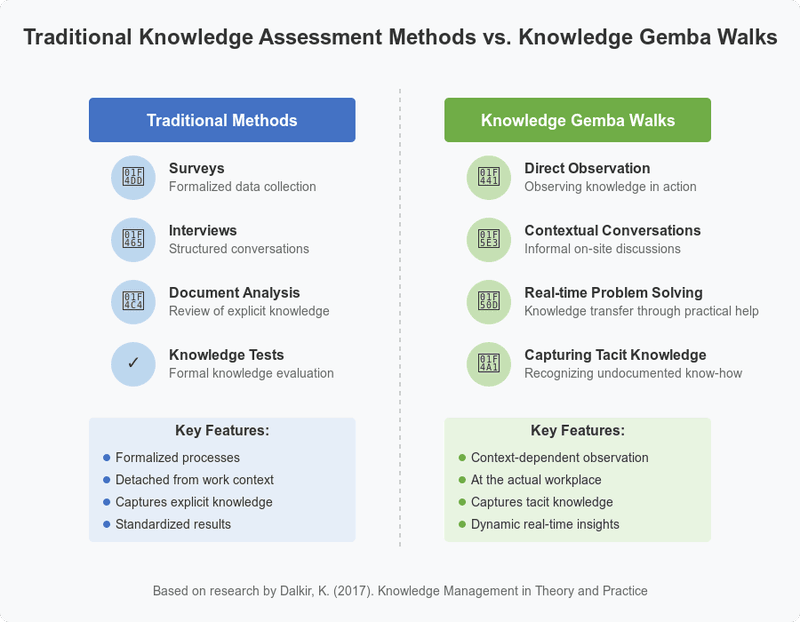
2. Preparing for a Knowledge Gemba Walk
2.1 Setting Clear Objectives
Before embarking on a Knowledge Gemba Walk, leaders must define what they aim to discover. Without clear objectives, observations may lack focus and yield superficial insights. Effective Knowledge Gemba Walks begin with specific questions related to organizational knowledge flows.
Possible objectives might include:
- Identifying critical knowledge that exists only in tacit form
- Understanding how information flows between departments
- Discovering barriers to knowledge sharing
- Mapping where expertise resides for critical business processes
- Identifying knowledge loss risks (e.g., retirement, turnover)
- Understanding how employees actually find solutions to problems
- Examining the effectiveness of existing knowledge management tools
By clearly defining what you want to learn, you can focus your observations appropriately. For instance, if your objective is to understand where critical engineering expertise resides, you would pay particular attention to how engineers solve complex problems, whom they consult, and what resources they use.
These objectives should align with broader organizational goals. For example, if innovation is a strategic priority, your Knowledge Gemba Walk might focus on how ideas are shared and developed across the organization. If customer satisfaction is the focus, you might examine how customer-facing staff access and apply knowledge to solve client problems.
Document your objectives clearly, but remain open to unexpected discoveries. One of the strengths of the Gemba approach is its ability to reveal unanticipated insights that more structured assessment methods might miss.
2.2 Selecting Target Areas and Participants
A comprehensive Knowledge Gemba Walk across an entire organization would be impractical and overwhelming. Instead, select specific areas based on your objectives. Consider focusing on:
- Departments with high knowledge intensity
- Teams experiencing performance issues that might relate to knowledge gaps
- Areas with upcoming retirements or high turnover
- Processes that cross departmental boundaries
- Projects that require significant collaboration and knowledge sharing
The selection of participants is equally important. Include a mix of roles and experience levels to gain diverse perspectives:
- Senior employees who hold significant institutional knowledge
- Newer team members who can highlight onboarding and learning challenges
- Bridge roles that connect different departments or teams
- Subject matter experts in critical domains
- Frontline employees who apply knowledge in day-to-day operations
Before the walk, communicate clearly with all participants about the purpose and process. Emphasize that this is not an audit or performance evaluation but a collaborative effort to improve knowledge flows. When Mitarbeiter [employees] understand that the goal is to identify system improvements rather than individual shortcomings, they are more likely to engage openly and honestly.
2.3 Developing an Observation Framework
To structure your observations during the Knowledge Gemba Walk, develop a framework of key aspects to observe. This helps ensure consistency and comprehensiveness without overly constraining what you notice. A balanced framework might include:
Knowledge Sources and Resources:
- What information sources do employees consult?
- How do they distinguish between authoritative and questionable sources?
- Which resources (databases, documentation, colleagues) do they rely on most?
Knowledge Flows and Barriers:
- How does information move between teams and departments?
- Where do knowledge transfers break down?
- What formal and informal channels are used for knowledge sharing?
Tacit Knowledge Indicators:
- When do employees seek help from specific colleagues rather than documentation?
- What expertise appears to reside primarily in people's heads?
- How is experience-based knowledge shared with newer employees?
Knowledge Application:
- How is knowledge applied to solve problems?
- What decision-making processes are visible?
- How do employees validate or question the knowledge they use?
Knowledge Management Tools and Practices:
- Which knowledge management tools are actually used (versus available)?
- How do employees organize their personal knowledge?
- What informal knowledge practices have emerged organically?
Avoid turning this framework into a rigid checklist that might narrow your observations. Instead, use it as a mental guide to ensure you're attentive to different aspects of organizational knowledge. The power of Gemba is in observing work as it naturally occurs, not in imposing a predetermined structure on it.
Consider creating a simple note-taking template organized around these categories to help capture observations efficiently without disrupting the flow of work you're observing.
2.4 Establishing the Right Mindset
The success of a Knowledge Gemba Walk depends greatly on the mindset of those conducting it. Leaders must approach the exercise with genuine curiosity and respect, setting aside assumptions about how work should be done to observe how it actually happens.
Key mindset principles include:
Curiosity over Judgment: Approach observations with genuine interest rather than evaluative judgment. Ask "why" before concluding what's right or wrong.
Respect for Expertise: Acknowledge that frontline employees often possess deep knowledge about their work that may not be visible in organizational charts or job descriptions.
Patience for Emergence: Allow patterns and insights to emerge gradually rather than rushing to conclusions. Knowledge dynamics rarely reveal themselves immediately.
Openness to Surprise: Be prepared to have your assumptions challenged. Some of the most valuable insights come from discovering that reality differs from what management believes happens.
Humility about Knowledge: Recognize that no single perspective—including leadership's—captures the full complexity of organizational knowledge.
Leaders conducting Gemba Walks should practice active listening and observation skills. This includes noting not just what is said but also what remains unsaid, observing body language and workplace arrangements, and paying attention to the tools and artifacts that support knowledge work.
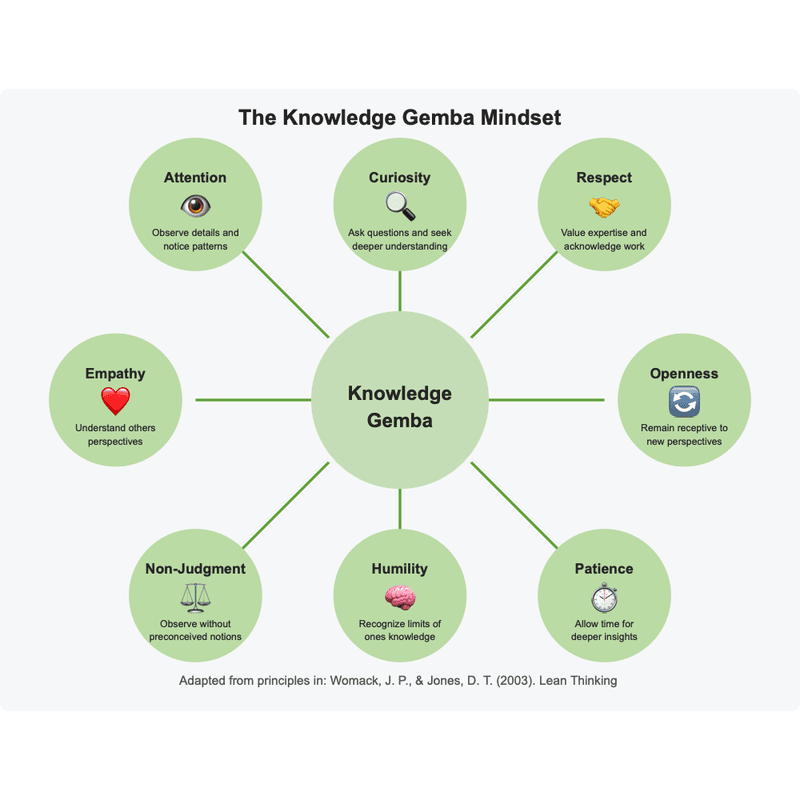
3. Conducting the Knowledge Gemba Walk
3.1 Observation Techniques
The core of the Knowledge Gemba Walk is direct observation of knowledge work as it happens. Unlike manufacturing Gemba Walks where physical processes are easily visible, knowledge work requires more nuanced observation techniques.
Job Shadowing: Follow selected employees through their normal workday, observing how they access, use, and share knowledge. This provides context-rich insights into real knowledge practices rather than idealized descriptions.
When shadowing, position yourself to observe without disrupting normal work patterns. Take notes discreetly, focusing on knowledge interactions: moments when employees seek information, make decisions, or communicate insights to others.
Work Environment Analysis: Examine the physical and digital workspaces for evidence of knowledge management practices:
- Notes and reminders on desks or walls
- Personal documentation or reference materials
- Organization of digital files and resources
- Tools and artifacts that support knowledge work
Interaction Mapping: Document patterns of communication and consultation:
- Who do employees turn to with questions?
- How frequently do cross-departmental interactions occur?
- Which communication channels (email, chat, in-person) are preferred for different types of knowledge sharing?
Process Tracing: Follow specific knowledge-intensive processes from start to finish:
- How is information gathered, transformed, and applied?
- Where are decisions made, and based on what knowledge?
- How are outcomes documented and lessons captured?
Throughout observation, maintain a balance between structure and openness. Have your framework in mind, but remain receptive to unexpected patterns and practices that might reveal important aspects of organizational knowledge.
3.2 Effective Questioning Strategies
While observation forms the foundation of the Knowledge Gemba Walk, thoughtful questioning enhances understanding and reveals aspects of knowledge work that may not be immediately visible. The art of Gemba questioning differs from interviewing; it's more contextual, timely, and directly related to observed activities.
Effective Gemba questions are open-ended, non-judgmental, and focused on understanding rather than evaluation. They often follow the "5 Whys" technique popularized in lean management—asking "why" repeatedly to dig deeper into root causes rather than accepting surface explanations.
Examples of effective knowledge-focused Gemba questions include:
Process Understanding:
- "I noticed you checked that document first—what makes that resource particularly helpful?"
- "When you encountered that problem, how did you decide whom to ask for help?"
- "What steps do you typically take when you need information that isn't documented?"
Knowledge Location:
- "If you were unavailable, who else would know how to handle this situation?"
- "Where is this process documented, if at all?"
- "How did you learn to perform this task originally?"
Knowledge Barriers:
- "What makes it challenging to find the information you need?"
- "Are there aspects of your work that you find difficult to explain to new team members?"
- "What knowledge would make your job easier if it were more accessible?"
Improvement Possibilities:
- "If you could change one thing about how information flows in your department, what would it be?"
- "What knowledge do you think is most at risk of being lost when people leave?"
- "How could the organization better capture the expertise you've developed?"
When asking questions, timing matters. Rather than interrupting work, look for natural pauses or reflection points. Frame questions as genuine curiosity rather than interrogation, and give employees time to think before responding. Research by Harvard Business School professor Amy Edmondson has shown that psychological safety—feeling able to share thoughts without fear of negative consequences—is crucial for honest knowledge sharing.
Document both the questions and answers, noting hesitations, qualifications, or particularly emphatic responses that might indicate areas of significance.
3.3 Documenting Observations
Systematic documentation transforms Gemba observations from fleeting insights into actionable knowledge. Effective documentation captures not just what was observed but also the context, patterns, and potential implications.
During the Walk: Use a combination of methods to document observations without disrupting the natural flow of work:
- Brief, timestamped notes capturing key observations
- Sketches of workspace layouts or interaction patterns
- Photography (with permission) of knowledge artifacts or workspaces
- Voice recordings of reflections between observations (not during them)
Documentation Focus Areas: Organize documentation around key knowledge dimensions:
- Knowledge sources (where information comes from)
- Knowledge flows (how information moves between people and departments)
- Knowledge barriers (where information gets stuck or lost)
- Knowledge artifacts (tools, documents, systems that support knowledge work)
- Knowledge gaps (areas where needed information is missing or inaccessible)
Documentation Best Practices:
- Distinguish between direct observations and interpretations
- Capture verbatim quotes that illustrate key insights
- Note contradictions between stated processes and actual practice
- Document both formal and informal knowledge practices
- Record questions that arise for future exploration
After each observation session, set aside time for immediate reflection and more comprehensive documentation. The richest insights often emerge in this reflection phase, as patterns become visible across multiple observations.
Consider using a structured template for consistency across different observation sessions, but remain flexible enough to capture unique insights that don't fit neatly into predetermined categories.
3.4 Respecting the Observed Work
A successful Knowledge Gemba Walk requires maintaining the integrity of the work being observed while gathering meaningful insights. This balance is particularly important in knowledge work, where observation itself can change thinking and behavior.
Minimizing Disruption:
- Maintain a low profile during observation to avoid changing normal work patterns
- Schedule observations during typical work periods, not exceptional circumstances
- Limit the number of observers to prevent overwhelming employees
- Avoid interjecting opinions or suggestions during the observation phase
Building Trust:
- Clearly communicate that the purpose is understanding, not evaluation
- Honor confidentiality concerns related to sensitive knowledge
- Share observation notes with participants when appropriate
- Demonstrate genuine interest in employees' expertise and perspectives
Respect extends beyond the observation itself to how the gathered information is used. Ensure that insights are applied to improve systems and processes, not to critique individual performance. When employees see that their open participation leads to positive changes, trust in the process grows.
The most valuable Knowledge Gemba Walks occur when employees feel comfortable enough to show not just their successes but also their challenges and workarounds. This authentic picture of knowledge work is only possible in an atmosphere of mutual respect and shared purpose.
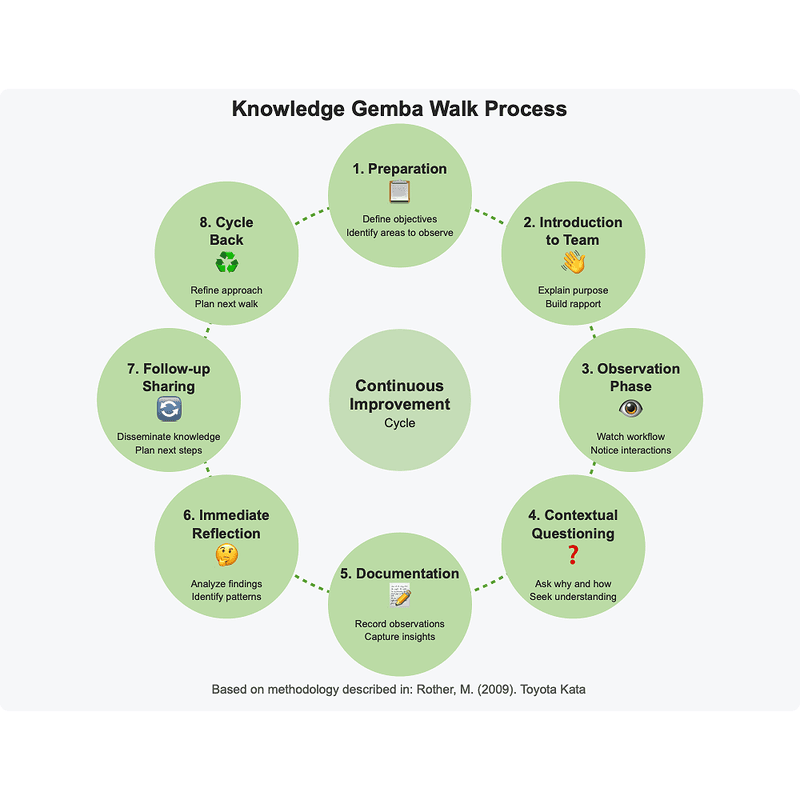
4. Analyzing Gemba Observations
4.1 Identifying Knowledge Patterns and Gaps
After conducting Knowledge Gemba Walks, the next critical step is systematic analysis of the observations to identify meaningful patterns and significant knowledge gaps. This analysis transforms isolated observations into actionable insights.
Pattern Recognition Techniques:
Start by categorizing observations according to key knowledge dimensions:
- Knowledge Sources: Where do employees get information? Are they relying on official documentation, specific colleagues, or workarounds?
- Knowledge Flows: What patterns emerge in how information moves between individuals and departments? Are there consistent bottlenecks or bypass routes?
- Knowledge Applications: How is available knowledge applied to problems? Are there variations in how different employees use similar information?
- Knowledge Retention: What mechanisms exist for preserving critical knowledge? Where is expertise at risk of being lost?
Look for both similarities and contradictions across different observation sessions. When multiple employees demonstrate the same knowledge-seeking behavior (such as consulting a specific colleague rather than official documentation), this indicates a significant pattern. Similarly, when stated procedures conflict with observed behaviors, this reveals important gaps between formal and actual knowledge practices.
Knowledge Gap Analysis:
Knowledge gaps typically fall into several categories:
- Accessibility Gaps: Knowledge exists but is difficult to access when needed
- Documentation Gaps: Critical knowledge remains tacit rather than explicit
- Transfer Gaps: Knowledge doesn't flow effectively between individuals or departments
- Application Gaps: Available knowledge isn't consistently applied to relevant situations
- Retention Gaps: Valuable knowledge is at risk due to personnel changes or inadequate capture
For each identified gap, assess its potential impact on organizational performance, innovation capacity, and risk exposure. Prioritize gaps based on both severity and strategic importance to the organization.
4.2 Mapping Knowledge Networks
One of the most valuable outcomes of Knowledge Gemba Walks is the ability to map actual knowledge networks—the informal pathways through which information and expertise flow in the organization. These networks often differ significantly from formal organizational structures but play a crucial role in knowledge management.
Identifying Knowledge Nodes:
Through Gemba observations, identify key knowledge roles within the organization:
- Knowledge Hubs: Individuals who serve as central repositories of information, frequently consulted by colleagues across departments
- Knowledge Brokers: People who connect different departments or domains, translating and transferring knowledge between groups
- Knowledge Gatekeepers: Those who control access to specific information, either formally or informally
- Knowledge Creators: Individuals who regularly generate new insights, approaches, or solutions
Mapping Knowledge Relationships:
Document the relationships between different knowledge nodes and departments:
- Direction of knowledge flow (one-way or reciprocal)
- Frequency of knowledge exchange
- Types of knowledge shared (procedural, contextual, technical)
- Formal vs. informal knowledge channels
- Strength of knowledge connections
Create visual maps of these knowledge networks to make patterns explicit. Research by social network analysts like Rob Cross has demonstrated that visualizing knowledge networks makes invisible collaborations visible and helps organizations leverage their intellectual resources more effectively. These visualizations often reveal surprising patterns—such as critical knowledge bottlenecks or unexpected bridges between departments—that wouldn't be apparent from organization charts alone.
Pay particular attention to single points of failure in knowledge networks: individuals who serve as sole repositories for critical information or the only bridges between otherwise disconnected groups. These represent significant organizational vulnerabilities from a knowledge management perspective.
4.3 From Observation to Insight
The ultimate goal of analyzing Gemba observations is to develop meaningful insights that can drive knowledge management improvements. This requires moving beyond description to interpretation and implication.
Insight Development Process:
- Aggregation: Combine observations across multiple Gemba Walks to identify broader patterns
- Contextualization: Consider how observed knowledge practices relate to business outcomes, strategic goals, and organizational challenges
- Interpretation: Develop explanatory hypotheses about why certain knowledge patterns exist
- Validation: Test interpretations through targeted follow-up questions or focused observations
- Implication Analysis: Determine what the insights mean for organizational performance, innovation, and risk
Types of Insights to Develop:
- Causal Relationships: Understanding why certain knowledge practices have emerged
- Hidden Dependencies: Identifying unstated relationships between knowledge domains
- System Dynamics: Recognizing how organizational structures and incentives shape knowledge flows
- Cultural Factors: Understanding how organizational culture influences knowledge sharing and application
- Improvement Opportunities: Identifying specific interventions that could enhance knowledge management
Effective insights connect observations to actions. Rather than simply noting that "knowledge is siloed between departments," a useful insight might be: "Cross-departmental knowledge sharing is inhibited by conflicting terminology and lack of regular interaction opportunities, resulting in duplicated effort and inconsistent customer information."
Document these insights in clear, specific language that captures both the observation and its significance. The best insights provide an "aha moment" that helps stakeholders understand knowledge dynamics in a new way.
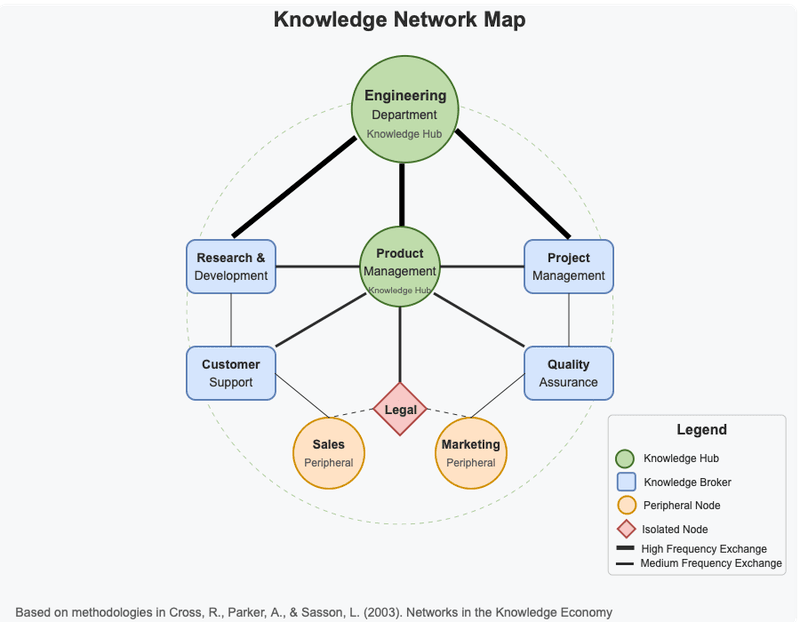
5. From Insight to Action
5.1 Developing Knowledge Management Initiatives
The true value of Knowledge Gemba Walks emerges when insights are translated into concrete initiatives that improve how knowledge is captured, shared, and applied throughout the organization. Effective initiatives address specific gaps identified during the Gemba process while aligning with broader organizational goals.
Categories of Knowledge Management Initiatives:
1. Knowledge Capture and Documentation:
- Creating templates for documenting crucial processes
- Implementing "knowledge handover" procedures before employee departures
- Establishing regular knowledge harvesting sessions with subject matter experts
- Developing case libraries that preserve decision contexts and rationales
2. Knowledge Sharing and Transfer:
- Creating communities of practice around critical knowledge domains
- Implementing mentoring or shadowing programs for tacit knowledge transfer
- Designing cross-training rotations to spread expertise across teams
- Establishing knowledge-sharing forums (virtual or physical)
3. Knowledge Access and Retrieval:
- Improving knowledge base search capabilities
- Creating knowledge maps that guide employees to relevant information
- Implementing expertise locator systems
- Redesigning information architecture based on observed user needs
4. Knowledge Application and Decision Support:
- Developing decision frameworks that incorporate organizational learning
- Creating checklists or job aids based on expert practices
- Implementing after-action reviews to capture and apply lessons learned
- Developing contextualized FAQ resources based on common issues
5. Knowledge Culture and Governance:
- Revising performance metrics to recognize knowledge sharing
- Establishing knowledge stewardship roles and responsibilities
- Creating recognition programs for knowledge contribution
- Implementing regular knowledge risk assessments
For each initiative, clearly define the specific knowledge gap it addresses and how it will improve organizational performance. Prioritize initiatives based on strategic impact, implementation feasibility, and resource requirements. Consider both quick wins that demonstrate immediate value and longer-term initiatives that address fundamental knowledge management challenges.
5.2 Implementing Change Through Rapid Experiments
Rather than attempting large-scale knowledge management transformations, use insights from Knowledge Gemba Walks to design targeted experiments that test potential solutions. This approach reduces risk, accelerates learning, and builds momentum through visible successes.
Designing Knowledge Management Experiments:
- Identify a specific knowledge gap revealed by Gemba observations
- Define a clear hypothesis about how an intervention might address the gap
- Design a small-scale, time-limited experiment to test the hypothesis
- Establish specific, measurable success criteria for evaluating results
- Implement the experiment with appropriate documentation and monitoring
- Evaluate outcomes against success criteria and gather participant feedback
- Scale successful approaches or pivot based on learnings
Example Experiment Framework:
Gap: Technical support specialists repeatedly solve the same customer issues because solutions aren't effectively shared across the team.
Hypothesis: A structured "solution story" template and weekly sharing session will increase solution reuse and reduce duplicate problem-solving.
Experiment: Implement template and weekly 30-minute sharing sessions for one month with half the support team (experimental group) while the other half continues current practices (control group).
Success Criteria: 20% reduction in time spent solving previously addressed issues; positive feedback from participants; 50% of documented solutions reused at least once.
This experimental approach aligns with established change management principles and the concept of "minimum viable changes" advocated by agile methodologies. Research on organizational learning by David Garvin (Harvard Business School) and Amy Edmondson has shown that smaller, iterative changes often produce more sustainable results than sweeping transformations, particularly in knowledge management initiatives where culture and behavior change are essential.
For each experiment, ensure clear ownership, appropriate resources, and regular check-ins to monitor progress and address barriers. Document both successes and failures as valuable learning that informs future knowledge management efforts.
5.3 Measuring the Impact of Knowledge Improvements
Demonstrating the value of knowledge management initiatives is crucial for sustaining support and scaling successful approaches. Develop meaningful metrics that connect knowledge improvements to business outcomes that matter to stakeholders.
Categories of Knowledge Management Metrics:
Process Metrics:
- Reduction in time spent searching for information
- Increase in knowledge reuse (vs. "reinventing the wheel")
- Improvement in cross-department knowledge access
- Reduction in duplicate knowledge artifacts
Quality Metrics:
- Decrease in errors due to knowledge gaps
- Improvement in decision quality and consistency
- Reduction in quality issues stemming from knowledge transfer problems
- Increased adherence to best practices
Outcome Metrics:
- Faster onboarding to full productivity
- Improved innovation metrics (ideas implemented, time to market)
- Enhanced customer satisfaction related to knowledge application
- Reduction in business risks from knowledge dependencies
Return on Investment Metrics:
- Cost savings from reduced rework or duplicated effort
- Value of time saved through improved knowledge access
- Revenue impact of knowledge-enabled improvements
- Risk mitigation value (particularly for critical expertise retention)
For each metric, establish a clear baseline before implementing initiatives, based on data gathered during Knowledge Gemba Walks or other assessments. Define both leading indicators (early signs of improvement) and lagging indicators (ultimate business impacts) to provide a comprehensive view of progress.
Remember that not all knowledge value is directly quantifiable. Supplement quantitative metrics with qualitative assessments, including stories and case examples that illustrate how improved knowledge management has enhanced organizational capabilities or addressed specific challenges.
5.4 Creating Sustainable Knowledge Management Practices
The insights gained from Knowledge Gemba Walks should ultimately lead to sustainable knowledge management practices that become embedded in organizational routines rather than one-time initiatives. This requires addressing both structural and cultural dimensions of knowledge management.
Structural Enablers:
- Integration with Work Processes: Embed knowledge capture and sharing within normal workflows rather than adding them as separate activities
- Role Definition: Clarify knowledge management responsibilities at all levels, from individual contributors to executives
- Governance Framework: Establish policies, standards, and decision rights for knowledge management that align with organizational needs
- Technology Support: Implement appropriate tools based on actual user behaviors observed during Gemba Walks, not assumed workflows
- Measurement Systems: Incorporate knowledge management metrics into regular organizational performance reviews
Cultural Enablers:
- Leadership Modeling: Ensure leaders demonstrate knowledge-sharing behaviors and visibly value knowledge contribution
- Recognition Systems: Acknowledge and reward effective knowledge management practices
- Learning Orientation: Foster an environment where learning from both successes and failures is valued
- Collaborative Norms: Promote cross-boundary collaboration and reduce "knowledge is power" attitudes
- Psychological Safety: Create conditions where employees feel safe to admit knowledge gaps and seek help
Research by organizational learning scholars has consistently shown that sustainable knowledge management requires alignment between technological, structural, and cultural dimensions. As Ikujiro Nonaka noted in his seminal work on knowledge creation, organizations must cultivate not just the systems but also the shared context or "ba" (場) that enables meaningful knowledge exchange. Without attention to cultural and contextual factors, even the most sophisticated knowledge management systems will fail to deliver sustainable value.
Conduct follow-up Knowledge Gemba Walks periodically to assess how knowledge practices are evolving and identify new opportunities for improvement. This creates a virtuous cycle where observation leads to insight, insight to action, and action to improved knowledge dynamics that can be further observed and refined.
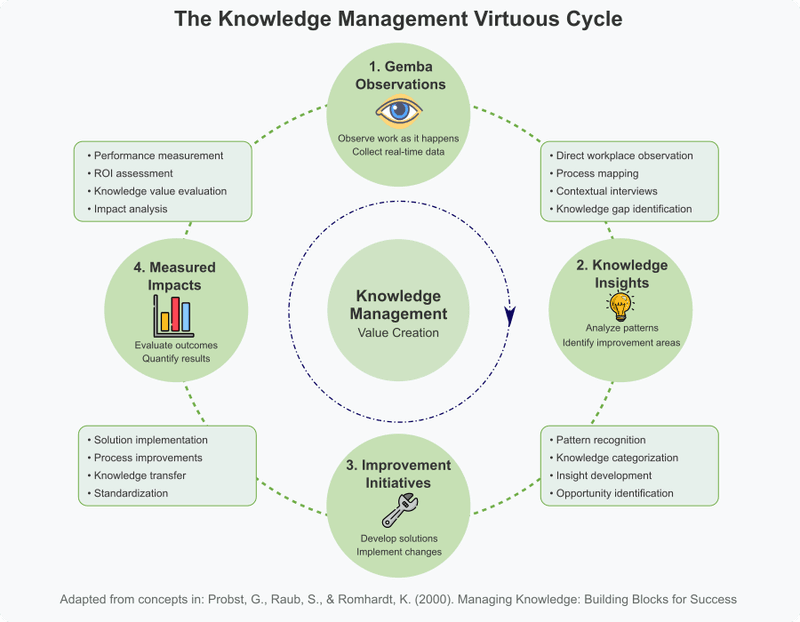
6. Case Examples: Knowledge Gemba in Action
6.1 Manufacturing SME: Preserving Critical Expertise
Organization Profile: A precision manufacturing company with 75 employees, specializing in custom components for the aerospace industry. The company faced an urgent knowledge management challenge: three senior machinists with over 40 years of combined experience were approaching retirement within the next two years.
Gemba Approach: The operations director conducted a series of Knowledge Gemba Walks focused specifically on how these senior machinists:
- Solved complex machining problems
- Made adjustments based on material variations
- Performed quality control assessments
- Maintained and calibrated specialized equipment
Rather than just asking the machinists to document their knowledge, the Gemba approach involved observing them during actual problem-solving situations, asking contextual questions, and noting both explicit procedures and tacit knowledge indicators (such as sensory cues they responded to or intuitive adjustments they made).
Key Insights:
- Critical quality judgments were based on tactile and auditory cues that weren't documented in any procedures
- Senior machinists had developed proprietary methods for specific challenging components that significantly reduced error rates
- Important machine calibration knowledge existed only in personal notebooks
- Junior machinists frequently consulted seniors about material variations, indicating a knowledge gap in adapting processes to different conditions
- Significant process knowledge was exchanged during shift handovers in casual conversations
Implemented Solutions:
- Created a comprehensive knowledge transfer program pairing each senior machinist with two junior colleagues for structured on-the-job training
- Developed video documentation of critical processes, focusing especially on capturing sensory aspects of quality judgment
- Implemented "technical storytelling" sessions where senior machinists shared problem-solving experiences with specific challenging jobs
- Created a structured process notebook with standardized templates for documenting adjustments, calibrations, and material-specific adaptations
- Revised shift handover procedures to ensure critical knowledge was systematically captured rather than exchanged casually
Results: The company reported an 85% retention of critical expertise after the senior machinists retired. Quality metrics remained stable through the transition, and training time for new machinists was reduced by 40% compared to previous cohorts. The company established ongoing Knowledge Gemba Walks as a regular practice to identify and transfer tacit knowledge throughout operations.
6.2 Professional Services Firm: Breaking Down Knowledge Silos
Organization Profile: A marketing consultancy with 120 employees across three offices, organized into specialized teams (strategy, creative, digital, and analytics). The firm was experiencing challenges with knowledge fragmentation between teams, resulting in inconsistent approaches to client problems and failure to leverage previous work.
Gemba Approach: A small team of partners conducted Knowledge Gemba Walks across all departments, focusing on:
- How teams accessed information about previous client projects
- When and how cross-team collaboration occurred
- How client briefs were interpreted and translated into deliverables
- What tools and resources different teams used for similar functions
The Gemba team shadowed project kickoffs, team meetings, and client presentations, paying particular attention to information flows at project transition points.
Key Insights:
- Each specialized team used different terminology for similar concepts, creating communication barriers
- Knowledge of client history was scattered across email threads, project management systems, and individual notes
- The digital team had developed innovative analytics approaches unknown to the strategy team
- Teams rarely reviewed case studies from other departments that might have relevant insights
- Physical office layout reinforced departmental silos by grouping specialists together
Implemented Solutions:
- Created an integrated client knowledge hub combining project history, key contacts, and strategic objectives
- Implemented cross-functional project teams with clear knowledge-sharing responsibilities
- Developed a shared glossary of terms to create common language across specialties
- Established regular "Innovation Exchange" sessions where teams shared new approaches
- Redesigned office space to create cross-functional work areas
- Implemented a "knowledge broker" role on large projects specifically responsible for connecting relevant insights across disciplines
Results: Six months after implementation, the firm reported a 30% increase in cross-team knowledge utilization and a 25% reduction in project rework due to information gaps. Client satisfaction scores improved by 18% on measures related to "cohesive approach," and employees reported greater awareness of complementary expertise across the organization. The firm subsequently expanded their Knowledge Gemba approach to include client stakeholders, gaining additional insights about knowledge transfer at client interfaces.
6.3 Healthcare Provider: Improving Knowledge at Point of Care
Organization Profile: A regional healthcare network including three hospitals and twelve outpatient facilities, with approximately 3,500 staff. The organization faced challenges with consistent application of best practices across facilities and effective knowledge sharing between specialized units.
Gemba Approach: A team of clinical leaders and quality improvement specialists conducted Knowledge Gemba Walks focusing on how:
- Clinicians accessed and applied clinical guidelines and protocols
- Teams shared patient information during handovers
- Staff located specialized expertise when needed for complex cases
- New evidence and practices were disseminated and adopted
- Learning from adverse events was captured and utilized
The Gemba team observed actual care delivery, shift changes, team huddles, and consultations, being careful to maintain patient privacy and minimize disruption to care.
Key Insights:
- Electronic health record (EHR) workflows often made relevant knowledge difficult to access at point of care
- Valuable practice innovations in one facility weren't systematically shared with others
- Shift handovers varied widely in structure and comprehensiveness
- Junior staff struggled to identify the right expert to consult for specific issues
- Post-event reviews focused on what went wrong but rarely captured what went right
Implemented Solutions:
- Redesigned EHR interface to embed knowledge resources within clinical workflows
- Created a "Practice Innovation Network" with designated champions at each facility
- Implemented standardized communication protocols for handovers (adapted from aviation industry)
- Developed an expertise directory with clear escalation pathways for different clinical scenarios
- Revised after-action review process to capture positive practices and unexpected successes
- Established regular cross-facility clinical Knowledge Gemba Walks to identify and spread best practices
Results: The healthcare network reported significant improvements in consistent protocol adherence (up 27%), reduction in handover-related care gaps (down 42%), and increased staff confidence in accessing appropriate expertise (up 35%). Patient safety indicators improved across all facilities, with the greatest gains in areas where care protocols had previously shown the most variation. The organization subsequently expanded their Knowledge Gemba practice to non-clinical areas including administration and patient experience.
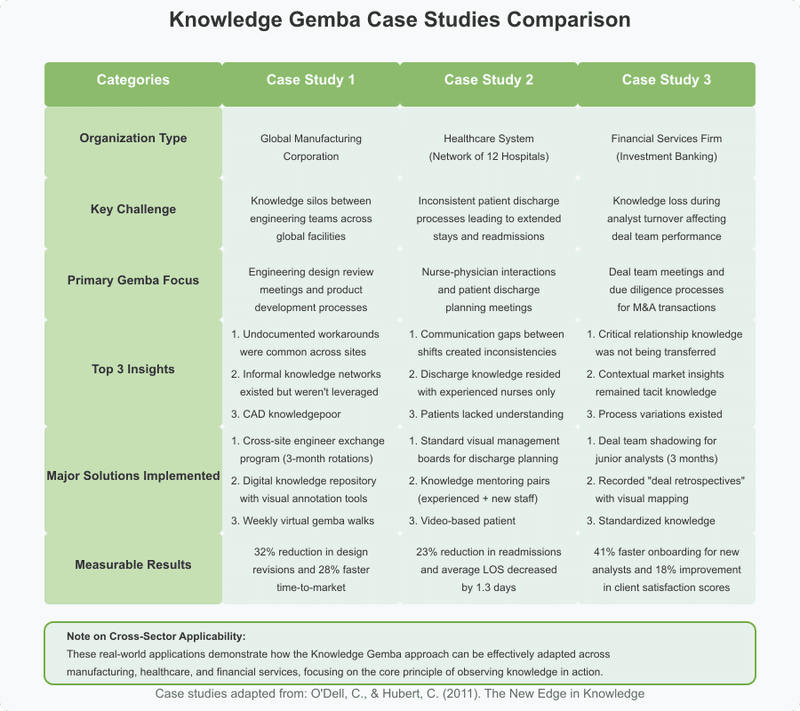
7. Integration with Existing Management Systems
7.1 Knowledge Gemba and Quality Management
Knowledge Gemba Walks can be effectively integrated with quality management systems, particularly those based on ISO 9001:2015, which explicitly requires organizations to manage organizational knowledge as a resource.
Alignment with ISO 9001:2015 Section 7.1.6: The ISO standard requires organizations to determine, maintain, and make available the knowledge necessary for operation and conformity. Knowledge Gemba Walks provide a systematic method for identifying:
- Where critical knowledge resides
- How knowledge is currently maintained and updated
- Gaps between available and necessary knowledge
- Risks to knowledge continuity
By incorporating Knowledge Gemba insights into quality management documentation, organizations can demonstrate compliance with knowledge requirements while implementing genuinely effective practices rather than superficial documentation.
Integration with Process Management: Quality management systems typically document key processes, responsibilities, and interactions. Knowledge Gemba observations can enhance these by:
- Identifying knowledge dependencies within processes
- Highlighting critical decision points where expertise is required
- Revealing informal knowledge practices that support formal processes
- Uncovering process variations that reflect adaptations to different contexts
Connection to Continual Improvement: Quality management systems emphasize continual improvement through the Plan-Do-Check-Act (PDCA) cycle. Knowledge Gemba Walks can be positioned as a "Check" activity that verifies how knowledge actually flows and identifies opportunities for improvement. The insights from Gemba observations then feed into improvement initiatives that complete the PDCA cycle.
Organizations that have already implemented ISO 9001:2015 or similar quality management frameworks can benefit from incorporating Knowledge Gemba Walks as an integral part of their approach to organizational knowledge management, strengthening both compliance and effectiveness.
7.2 Knowledge Gemba and Risk Management
Effective knowledge management is increasingly recognized as a critical component of organizational risk management. Knowledge Gemba Walks provide a powerful method for identifying and addressing knowledge-related risks.
Types of Knowledge Risks:
- Single-Point Knowledge: Critical expertise held by only one person
- Undocumented Knowledge: Essential processes that exist only in tacit form
- Knowledge Obsolescence: Outdated information still in circulation
- Knowledge Gaps: Areas where necessary expertise is missing
- Knowledge Transfer Failures: Breakdowns in sharing critical information
- Knowledge Misapplication: Improper use of available knowledge
Knowledge Gemba Walks are particularly effective at revealing these risks because they observe actual knowledge practices rather than relying on what should happen according to policies or assumptions.
Integration with Enterprise Risk Management: Organizations can incorporate knowledge risk identification into their broader risk management framework by:
- Adding knowledge risk categories to risk registers
- Establishing knowledge risk indicators based on Gemba observations
- Defining risk tolerance levels for different types of knowledge
- Developing mitigation strategies for critical knowledge vulnerabilities
- Including knowledge risks in regular risk review processes
Connection to Business Continuity: Business continuity planning focuses on maintaining critical functions during disruptions. Knowledge Gemba Walks provide insight into knowledge dependencies that might threaten continuity, such as:
- Operational knowledge that could be lost during personnel changes
- Informal knowledge networks that might break down during reorganizations
- Knowledge resources that could become unavailable during system outages
- Decision processes that rely on specific expertise
By systematically identifying these dependencies through Gemba observations, organizations can develop more robust continuity plans that address knowledge dimensions often overlooked in traditional approaches.
7.3 Knowledge Gemba and Innovation Management
Innovation depends heavily on how effectively organizations leverage, combine, and extend their knowledge. Knowledge Gemba Walks can enhance innovation management by revealing how knowledge actually flows and identifying opportunities to stimulate creative connections.
Identifying Innovation Enablers and Barriers: Gemba observations can reveal:
- Cross-disciplinary connections where innovative ideas emerge
- Barriers that prevent knowledge recombination across domains
- Informal innovation practices that could be systematized
- Knowledge gaps that limit innovative potential
- Hidden expertise that could contribute to innovation initiatives
Enhancing Knowledge Diversity: Innovation often comes from combining diverse knowledge domains. Knowledge Gemba Walks can identify:
- Isolated pockets of expertise that could be connected
- Opportunities for cross-functional knowledge exchange
- External knowledge sources that could be better leveraged
- Diverse perspectives that aren't being included in innovation processes
Supporting Experimental Learning: Innovation requires effective learning from experiments. Knowledge Gemba can examine:
- How experimental results are captured and shared
- Whether learning from failures is preserved
- How insights from small experiments influence larger initiatives
- Where experimental knowledge gets lost or diluted
Organizations with formal innovation management systems can incorporate Knowledge Gemba Walks to ensure that their processes actually support the knowledge flows necessary for innovation, rather than creating bureaucratic barriers to creative combination and application of knowledge.
7.4 Creating an Integrated Knowledge Management Approach
Rather than treating Knowledge Gemba Walks as an isolated practice, forward-thinking organizations are incorporating them into a holistic knowledge management approach that addresses governance, technology, process, and culture dimensions.
Knowledge Governance Integration:
- Include Knowledge Gemba insights in knowledge management strategy development
- Use Gemba observations to inform knowledge management policies and standards
- Establish clear ownership for addressing knowledge gaps identified through Gemba
- Connect Gemba findings to knowledge performance indicators
Technology Alignment:
- Base knowledge management technology requirements on actual observed behaviors
- Test knowledge tools in real work contexts before full implementation
- Use Gemba insights to improve knowledge system interfaces and workflows
- Assess technology adoption through follow-up Gemba observations
Process Embedding:
- Incorporate knowledge capture and sharing steps into standard operating procedures
- Design knowledge transfer checkpoints at critical process transitions
- Use process mapping to identify key knowledge decision points
- Establish feedback loops that capture process knowledge improvements
Cultural Reinforcement:
- Use Gemba observations to identify cultural enablers and barriers to knowledge sharing
- Recognize and celebrate positive knowledge behaviors observed during Gemba
- Address cultural obstacles with targeted interventions
- Develop leadership practices that reinforce knowledge values
By integrating Knowledge Gemba Walks with these complementary dimensions of knowledge management, organizations create a comprehensive approach that addresses both formal and informal aspects of how knowledge flows and is utilized.
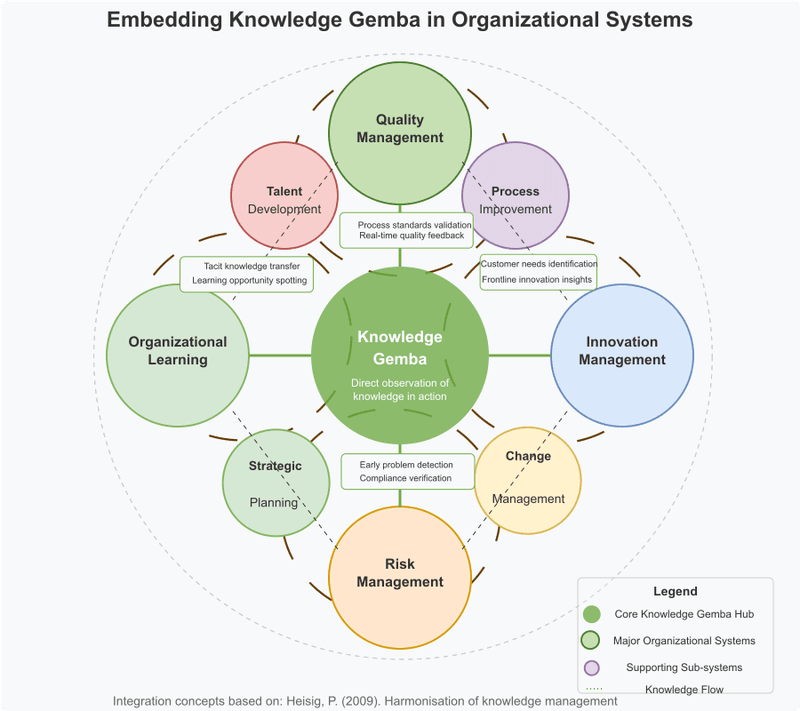
8. Conclusion: The Way Forward
8.1 Knowledge Gemba as a Strategic Tool
As organizations increasingly compete on the basis of what they know and how effectively they apply that knowledge, approaches that provide deep insight into knowledge dynamics become strategically valuable. Knowledge Gemba Walks offer a distinctive advantage by revealing the human, contextual, and tacit dimensions of organizational knowledge that remain invisible to conventional assessment methods.
Unlike document reviews, surveys, or interviews conducted outside the work context, Knowledge Gemba provides a window into how knowledge actually flows and is applied in day-to-day operations. This ground-level truth allows leaders to:
- Identify critical knowledge assets that don't appear on balance sheets
- Understand knowledge vulnerabilities before they become crises
- Discover informal knowledge practices that drive performance
- Recognize barriers to knowledge flow that limit organizational effectiveness
- Design interventions that address root causes rather than symptoms
The strategic value of Knowledge Gemba extends beyond immediate problem-solving to building long-term organizational capabilities. By systematically observing, understanding, and enhancing knowledge processes, organizations develop what Peter Senge termed "learning organization" characteristics—the ability to adapt, innovate, and evolve in response to changing conditions.
8.2 Evolving the Practice
Like any management approach, Knowledge Gemba Walks should evolve to address changing organizational needs and incorporate new insights. Several promising directions for evolution include:
Virtual and Hybrid Gemba: As remote and distributed work becomes more common, adapting Gemba techniques to virtual environments is essential. This might involve observing virtual collaboration sessions, analyzing digital workspace arrangements, or examining how knowledge flows in hybrid meetings. While challenging, virtual Gemba can reveal important insights about how knowledge dynamics shift when physical co-location is reduced.
AI-Enhanced Knowledge Mapping: Combining human observation with data analytics offers potential for more comprehensive knowledge mapping. Analysis of communication patterns, document access, and collaboration networks can complement direct Gemba observations, revealing patterns that might not be visible through observation alone. However, these approaches should supplement rather than replace the contextual understanding that comes from direct human observation.
Cross-Organizational Gemba: Extending Knowledge Gemba beyond organizational boundaries to examine knowledge flows with customers, suppliers, and partners can reveal important insights about external knowledge dependencies and opportunities. This expanded scope recognizes that critical knowledge often exists at organizational interfaces rather than solely within internal departments.
Participatory Gemba Approaches: Evolving from leader-led observation to more participatory approaches where employees become active contributors to the Gemba process can enhance engagement and insight. Training employees to conduct peer Gemba observations or facilitating team-based knowledge mapping sessions can distribute the practice throughout the organization.
8.3 Building a Knowledge-Conscious Organization
The ultimate goal of Knowledge Gemba Walks is not just to implement specific knowledge management solutions but to develop an organization-wide consciousness about knowledge as a strategic resource. This consciousness is reflected in how people think about, value, and engage with knowledge in their daily work.
In a knowledge-conscious organization:
- Employees at all levels recognize their role in knowledge creation and sharing
- Teams regularly reflect on what they know, what they need to know, and how knowledge flows
- Leaders explicitly consider knowledge implications in strategic and operational decisions
- Systems and processes are designed with knowledge dynamics in mind
- Learning and knowledge sharing are integrated into daily work rather than treated as separate activities
Knowledge Gemba Walks contribute to this consciousness by making knowledge dynamics visible, creating a shared language for discussing knowledge issues, and demonstrating organizational commitment to understanding and improving how knowledge works.
As management scholar Henry Mintzberg observed, "Managing requires a sophisticated understanding of the work being managed." In knowledge-intensive organizations, this understanding must extend beyond visible workflows to the invisible but crucial knowledge that underpins all organizational activity. Knowledge Gemba Walks provide a structured yet flexible approach to developing this understanding and translating it into improved organizational performance.
By going to see, asking why, and engaging respectfully with those who do the work, leaders can uncover the living knowledge ecosystem of their organization and nurture its continued development. In a world where knowledge has become the primary source of competitive advantage, this capability is not just useful but essential.
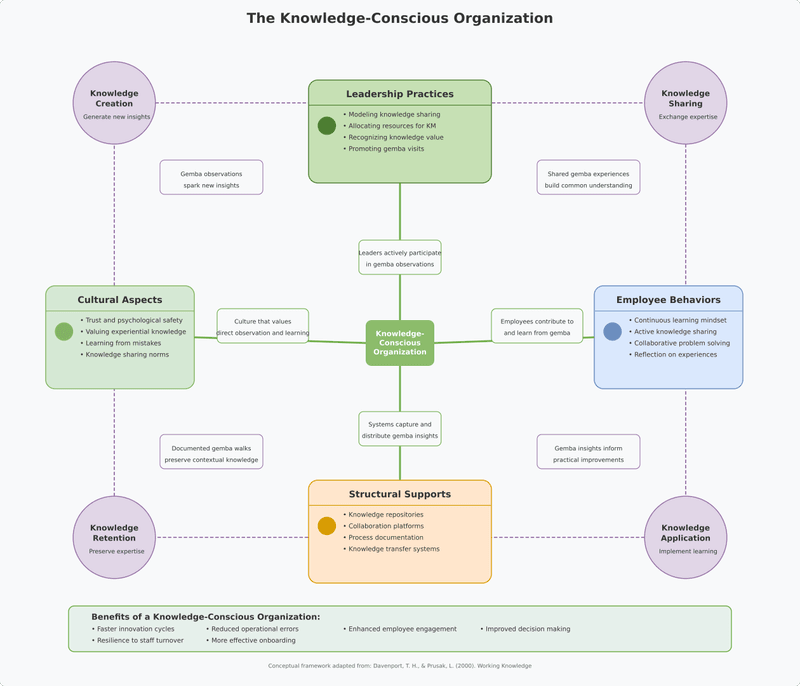
References
Dalkir, K. (2017). Knowledge Management in Theory and Practice (3rd ed.). MIT Press. ISBN: 978-0262036870
Nonaka, I., & Takeuchi, H. (1995). The Knowledge-Creating Company: How Japanese Companies Create the Dynamics of Innovation. Oxford University Press. ISBN: 978-0195092691
Rother, M. (2009). Toyota Kata: Managing People for Improvement, Adaptiveness and Superior Results. McGraw-Hill. ISBN: 978-0071635233
Womack, J. P., & Jones, D. T. (2003). Lean Thinking: Banish Waste and Create Wealth in Your Corporation. Free Press. ISBN: 978-0743249270
Cross, R., Parker, A., & Sasson, L. (2003). Networks in the Knowledge Economy. Oxford University Press. ISBN: 978-0195159509
Edmondson, A. C. (2018). The Fearless Organization: Creating Psychological Safety in the Workplace for Learning, Innovation, and Growth. Wiley. ISBN: 978-1119477242
O'Dell, C., & Hubert, C. (2011). The New Edge in Knowledge: How Knowledge Management Is Changing the Way We Do Business. Wiley. ISBN: 978-0470917398
Probst, G., Raub, S., & Romhardt, K. (2000). Managing Knowledge: Building Blocks for Success. Wiley. ISBN: 978-0471997689
Davenport, T. H., & Prusak, L. (2000). Working Knowledge: How Organizations Manage What They Know. Harvard Business School Press. ISBN: 978-1578513017
